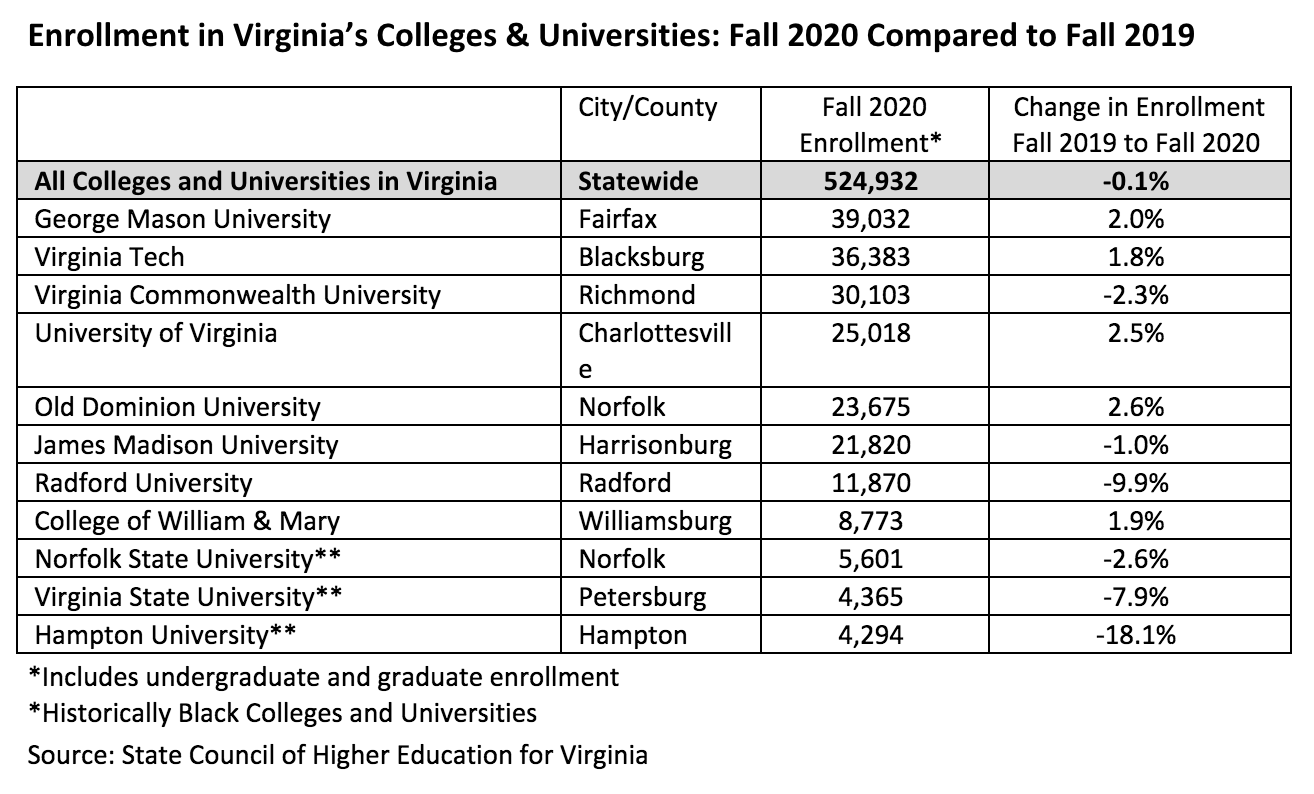The State of Student Housing
August 17, 2021
As students head back to in-person classes at Virginia’s colleges and universities, many will be settling into on-campus dorms, while others will be setting up off-campus apartments. While the COVID-19 pandemic drastically altered the school year last year, the student housing industry faces challenges and opportunities as the new year kicks off.
Fewer Students, Less Student Housing Demand
Student housing historically weathers recessions well, as college and university enrollment often increases during economic downturns. However, the COVID-19 recession had an unprecedented impact on colleges and universities. Campuses were closed and students were sent home. Reopening plans were started and stopped, leading to uncertainty for students, faculty, and staff, as well as for property owners in the surrounding community.
Nationally, Fall 2020 college enrollment numbers were down by 2.5% compared to Fall 2019. In Virginia, the number of students enrolled in colleges and universities was virtually unchanged from a year earlier, but there was a lot of variability in college enrollment trends. Last year, the number of students enrolled in the commonwealth’s largest public universities increased, while enrollment numbers were down significantly at some smaller colleges and universities, including some of Virginia’s historically black colleges and universities (HBCUs).
But even those colleges and universities that saw enrollment increases did not see all of their students living on or near campus last year. This year—at least as of mid-August—that seems poised to change.

During the pandemic, leasing activity slowed and vacancy rates surged in many university towns. However, the student housing sector has rebounded strongly. Industry analysts continue to believe there are tremendous upsides to investing in apartments in college towns. Furthermore, the development of on-campus housing is poised for innovation and growth.
Outlook for Student Housing
The National Multifamily Housing Council (NMHC) recently released two reports on the student housing market in the U.S. that examined demand for college and university housing and identified some important trends the student housing industry will be facing in the years to come. Below are some key takeaways from this research:
- Demographics will be the key factor influencing the demand for college and university housing. According to NMHC’s research, enrollment of 18‐ to 24‐year‐olds is expected to increase by an average annual rate of 1.1% between 2020 and 2031, resulting in an increase of 1.445 million new college and university students.
- For some colleges and universities and surrounding communities, enrollment of international students is critical to the demand for student housing. Forecasting international student enrollment is complicated because of uncertainties about how long the pandemic will last and what future immigration policy will be. Declining enrollment of international students could be partially offset by a decline in the number of U.S. students studying abroad because of the pandemic.
- Given an increasing demand for technical and professional service jobs and the large millennial population now aged 24 to 40, it is possible that there could be a surge in interest in graduate school programs, which could fuel unique student housing needs on university campuses.
- The COVID-19 pandemic highlighted the need for healthier buildings. Features of healthy student housing include buildings with good ventilation and air flow, increased daylight and access to outdoor space, and larger spaces for gathering.
- Off‐campus housing, with larger living spaces, is competing more with on-campus dorms. As a result, universities have been looking at less institutional designs for their residential options to encourage more students to stay on campus.
- The distance education trend has accelerated during the pandemic; however, virtual learning will not replace traditional public four‐year programs. Despite the upheaval to post-secondary education brought about by the COVID-19 pandemic, most students will still want an in-person college experience and an on- or near-campus living situation.
- Affordable housing options may be a differentiator for schools that are looking to draw students from a broader geography. Delivering lower-cost quality student housing will be easier in communities where there is a better housing supply‐demand balance and where public‐private partnerships have been fostered.
To read more about the state of the student housing market, check out other resources from NMHC.
Click here to send any comments or questions about this piece to Virginia REALTORS® Chief Economist Lisa Sturtevant, PhD.
*Information as of 08/17/21
You might also like…
Midway Through 2024, Virginia Home Sales Activity Slightly Outpacing Last Year
By Robin Spensieri - July 24, 2024
According to the June 2024 Virginia Home Sales Report released by Virginia REALTORS®, there were 10,018 homes sold across the commonwealth last month. This is 974 fewer sales… Read More
Three Multifamily Market Trends from the Second Quarter of 2024
By Sejal Naik - July 16, 2024
Each quarter, through its Multifamily Market report, the research team at Virginia REALTORS® analyzes the trends and changes in the multifamily market. Here, we share the key highlights… Read More
Takeaways From the JCHS 2024 State of the Nation’s Housing
By Dominique Fair - July 15, 2024
The Joint Center for Housing Studies from Harvard University released this year’s State of the Nation’s Housing report highlighting the impact today’s market is having on both homeowners… Read More